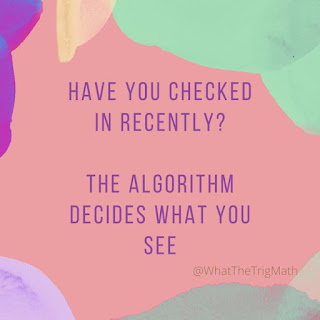I have debated writing this on my What The Trig blog as it began personal but it has ended up more open than that so it will sit here if that's OK?
I recently delivered some training to a college who part way through the demo the staff explained that they had seen this tool and demo before. They showed me partially completed tasks on the tool in question. I then asked "why are you here again?" followed by "why didn't you use it more?" and finally I said "I think it's because you haven't found your why"
The staff, knew how to use the tool. They had an idea of how it would enhance their teaching and learning. Yet they hadn't explored it fully, they didn't have a reason to do so. Their 'why' for being in training with me was about a manager telling them to attend. There were many interpretations of how to apply the tool I was demonstrating to the classroom. We spent time exploring our 'why'. This was much more valuable and staff left with examples to embed into teaching from the next day. Instead of a blanket CPD approach we worked together to find our 'why'.
Finding your 'why' is crucial for embedding changes in your practice. Teaching is a career that develops habits early doors that become hard to change. I am fascinated by the review work Hobiss, Sims and Allen (2020) on habit formation in teachers. It got me thinking about how early career teachers need very different CPD and training to experienced teachers. Not because one is better than the other or that we assume experienced teachers need less and early career teachers need more. I mean early career teachers and experienced teachers need different CPD and training because they are at different stages of habit formation. Their 'why' for making changes will have different motivations.
The 'why' of an early career teacher, in my own experience and that of mentoring teachers, is that their 'why' comes from forming good habits. Wanting to establish best practice, a thirst to learn. The 'why' of an experienced teacher is often, again in my experience of coaching staff, to change habits or develop new ones. Also born out of a thirst to learn and establish best practice. Yet how often does the CPD I deliver, you attend, offer this level of differentiation? What I am asked to deliver are brief whistle stop tours for experienced teachers and in depth training for early career teachers. That in depth training is often sadly extended to experienced teachers who are on performance management pathways too. I have had to battle with organisations to explain that I need staff to find their 'why' and we differentiate the sessions based on the staff's 'why'.
Finding your 'why' has also emerged for me seeing the increase in people attending CPD events online. The emergence of self development CPD being freely available online has seen attendance at events sky rocket for mine and for others. I was in a session recently and my 'why' for being there was to support a colleague and provide technical assistance. I looked at their attendees and saw people clearly multi tasking. They were listening of sorts. Attendees left near the end and asked for a recording so they could catch up later. What was their 'why' for being there? Was it because they didn't want to miss out or because they wanted to learn what my colleague had to share? I wish it was the latter.
A recording of a session is a great way to reflect and recall key points, I agree. Some people though partially listen live in the knowledge that they have a recording to look back over and they multi task in live sessions. I am curious if the videos ever go watched. I too have fallen into this trap of signing up to a million eventbrites to develop myself. I found I was unable to attend a few and felt guilty about taking a place and cancelled them. Upon reflection, my 'why' for booking on was because the CPD was there, it wasn't that I had a hunger to learn what was being shared. Finding my 'why' on this has now freed my diary up somewhat and I am enjoying reading and other activities instead. If something piques my interest I ask myself now, what is my 'why' for attending?
Social media is another place where I have found my 'why'. I was late to the party on social media as a wise person once said, there's no point in having a Twitter/LinkedIn page if you're not going to love it. It is for this reason I still don't have a LinkedIn page today. I do not have the time to devote to it. I would rather have no representation on the platform than a poor one. Forming JoyFM has meant I have had to open a new Twitter account and an Instagram account. This was a conscious decision. I had to consciously think about my 'why'. What would having this platforms bring me and JoyFM? Did I have the time to invest in them?
My 'why' for my Twitter as WhatTheTrigMath was to connect with people. Share work I was doing, education technology and maths tips. My 'why' was self interest in the first instance and it still is to a degree. It is a source of income for me as a self employed teaching and learning coach. I get DM's from people asking for me to deliver sessions so the 'why' is clear on that front. Yet there is an aspect to social media that has added a new dimension to me 'why'.
As well as connecting with others, I amplify others work. My 'why' is because I want to share other people's work and their stories. It is this 'why' that led me to form JoyFM. I want to provide a platform where all can share. On Twitter I want to RT lots and amplify more! I genuinely hold close to my heart the value that we are all better together. Moving past the hashtag be kind, I want to be kind and support others. Twitter isn't always positive, I am not naive. But the negative experiences count on one hand vs the hundreds of positive interactions every day.
I was recently on an Instagram live with Scott Hayden talking about digital wellbeing habits. Scott shared this with his students and we had a student focus. I shared some of my work as a common sense ambassador. Particularly the lessons from the digital citizenship curriculum on wellbeing. In one we look at the art by Eric Pickersgill. These images are so powerful. And again it got me asking, what is the 'why' for the people in the images with their phones? In my chat with Scott I shared my thoughts about scrolling endlessly and finding your purpose for being on the platform. Whatever platform you are on, are you active or passive? If you are active what is your 'why'? If you are passive what is your 'why'? This reflection has been powerful for me in stepping away from some spaces and throwing myself into others.
There are many aspects of life where we have 'whys' but how often do we stop and think, what is our 'why' for doing this? What are we hoping to achieve? How will we support others? How will things be improved by doing this. As society demands more from us I hope that we can all find our 'why' and be purposeful in our actions. SJ









